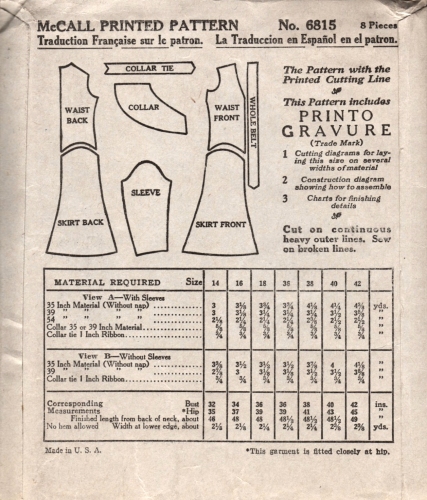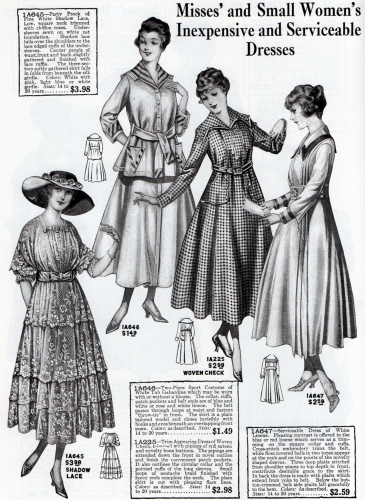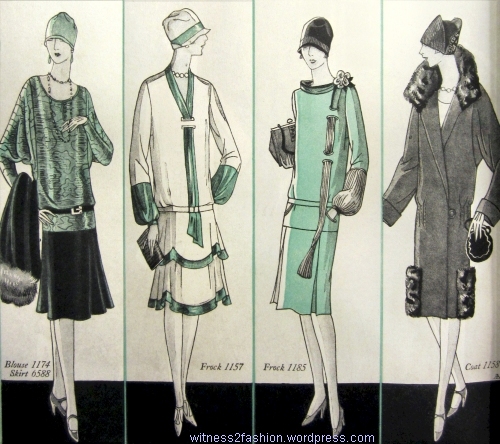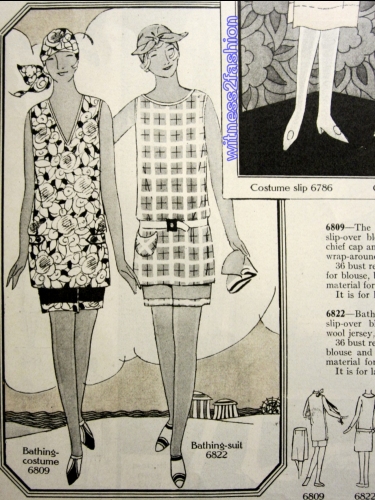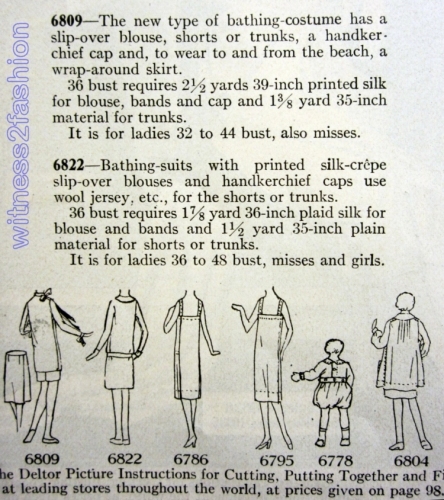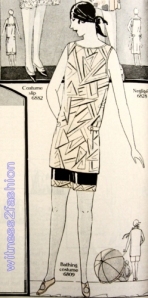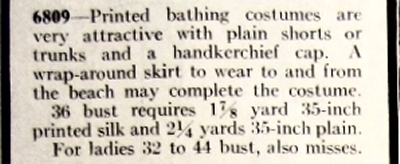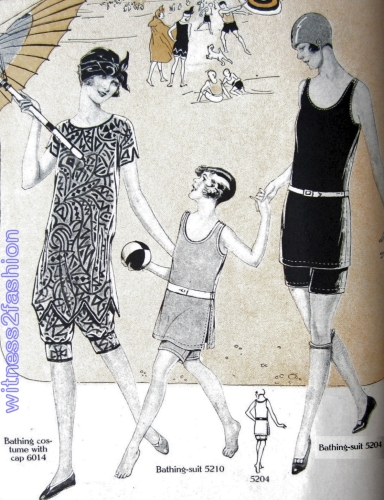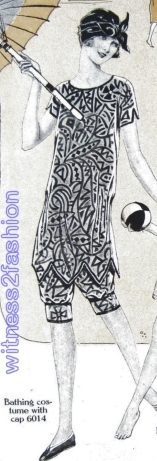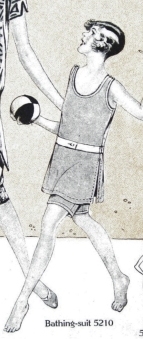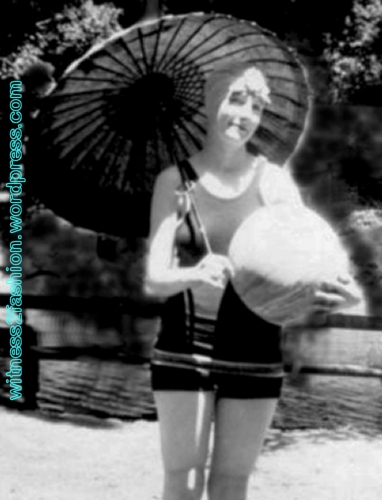When you’re looking at vintage magazines, catalogs, or patterns, sometimes you run across an item that says “Sizes 14 to 20 years” or “Size 16 years” — as if all 16 year-olds were the same size! Surprisingly, even magazines that sold patterns by mail, like Delineator and Ladies’ Home Journal, rarely explained pattern sizes in terms of measurements. Often you have to look at an actual pattern envelope to find a chart of size, bust, waist, and hip measurements.
Here are the “Corresponding Measurements:”

Corresponding Measurements chart from McCall #6815. McCall, unlike Butterick, did not say “Misses” and “Ladies,” but notice the sizes: 14, 16, 18, then 36, 38, 40, 42. Size 18 and Size 36 both have a 36″ bust.
This particular design was available in both Misses’ (14 to 18 years) and Ladies’ (Bust measurement 36 to 42 inches:)

Enlargement of “Corresponding Measurements” and sizes chart, McCall #6815. The only difference given between Size 18 and Size 36 is 1/2 inch in skirt length. There are no waist measurements — a hold-over from the 1920s, when they were irrelevant.
This McCall pattern assumes that, even in those narrow-hipped thirties’ fashions, the average woman would have hips three inches bigger than her bust.
Note that the smallest size, 14, is two inches shorter (46″) than the 16 and 18 (both 48″ long), and the Ladies’ sizes are mostly 48 1/2″ long. I wonder if size 18 had a shorter “nape to back waist” measurement than size 36, which had the same bust (36″) and hip (39″) measurements; issuing two different patterns for the sake of a 1/2 inch skirt length measurement seems silly.
Every pattern company (and catalog company) had its own version of “Misses” and “Ladies” sizing.

Size and Measurement chart from Ladies’ Home Journal pattern #1583, for a Ladies’ Dress, very late 1910s or early 1920s.
The Ladies’ Home Journal made all of its Ladies’ patterns the same length regardless of size: “Center-front skirt length from normal waistline is 39 inches.”
This Standard Designer pattern from the 1920’s . . .
. . . assumes that a 15-16 year old girl will be 2 inches shorter than a 17-18 year old, and four inches shorter than a grown woman:

Measurement and size chart from Standard Designer pattern #8626. Notice the difference in “Skirt Length Finished at Center Front below Normal Waistline;” 28 inches for size 16 Years, and 32 inches for all Ladies.
Pattern sizes were not standardized among companies until the late 1960’s, which is why the dark pink “New Sizing” box on an envelope is sometimes used for dating vintage patterns.
By the 1960s, the word “Misses” on a pattern meant what “Ladies” or “Women” used to mean: bust sizes from 34 to 40 inches. (The larger sizes, 42 and 44, had disappeared. )

Size and measurement chart from the back of the envelope for Simplicity #7528, dated 1968. “Juniors” is now the term for smaller, shorter sizes.
Misses’ Sizes for Butterick in the Nineteen Twenties
In the 1920s, Butterick sized its Misses’ patterns from 15 to 20 years, and Ladies’ patterns from 33″ (or 34″) bust to 44″ or larger. From comparing many pattern descriptions in Delineator, I’ve gleaned that Butterick’s Misses’ patterns used the following bust measurements in the 1920’s :
Butterick’s 15 years = 32″ bust
Butterick’s 16 years = 33″ bust
Butterick’s 17 years = 34″ bust
Butterick’s 18 years = 35″ bust
Butterick’s 19 years = 36″ bust
Butterick’s 20 years = 37″ bust
What’s more, Butterick often used the phrase “for misses 15 to 20 years, also small women,” which made me wonder,
“What was the difference between a Miss with a 34 inch bust, and a Lady with a 34 inch bust?”
You have probably already deduced that skirt length has something to do with it, but I got my first hint from the Ordering page of the 1917 Perry, Dame & Co. Catalog. [Women’s and Children’s Fashions of 1917: The Complete Perry, Dame & Co. Catalog, from Dover Books.]
Like Butterick, Perry Dame & Company distinguished between Misses’ and Women’s sizes. And, like Butterick, Perry, Dame also added the phrase “and smaller women” to some of its listings for Misses.
These dresses are for “Women:”
Like Butterick and other pattern companies, Perry, Dame & Company sold Women’s dresses by bust measurement — “32 to 46” in this case.
These dresses are for “Misses and Small Women:”
All the dresses on this page are sized “14 to 20 years.”
For the costumer, knowing whether a dress was meant to be worn by a teenager or an older woman is very important. However, it’s clear that it is the size range, not the style, that marks these dresses as suitable to Misses, since they are also appropriate for Small Women.
These Perry, Dame skirts are also offered in both Women’s and Misses’ sizes:

The catalog assigns different numbers to this skirt, depending on whether it is in Women’s Sizes or “Misses’ and Small Women’s Sizes.” p.51
A woman with a waist between 22 and 28 inches would order either skirt #5A32 or #5A62, depending on the length she needed. Women’s lengths ranged from 36 to 43 inches. Misses’ and Small Women’s lengths ran from 33 to 35 inches, a considerable difference — 6 or 7 inches — if you had a 28″ waist.
Deduction: Misses Are Shorter Than Ladies

Women’s Dress Sizes vs. Misses’ Dress Sizes; Perry, Dame Catalog, 1917. Exerpted from page 146. All Women’s dresses have a 40″ skirt length measurement. All Misses’ dresses are shorter.
Each company had its own size and measurement ideas, but the common assumption seems to be that women with a larger bust measurement will also be taller — which is not necessarily true. In fact, in the nineteen twenties and thirties (and later), older women — women born before the end of the 19th century — were more likely to be short, because of a less nutritious diet during childhood. (Many families lived on bread and soup for several months each year.) And most older women are aware of our tendency to burn fewer calories and to put on weight after menopause. Lynn, at American Age Fashion, has been following the question of patterns and ready-to-wear suited to the needs of the short and rotund. You can follow her research by starting with “Hunting for Half Sizes” (Lynn has made this into a multi-part series. Just search her site for “half sizes.”)
I’ve also noticed that, in the 1920’s, younger women were not necessarily shorter; but they wore shorter skirts than older women. To some extent, the 1920’s styles which seem most attractive to us today are the ones initially worn by Misses and teens.

Two Ladies’ patterns, left, and a Misses’ pattern, Dec. 1925. Butterick fashions from Delineator magazine. The Miss is showing a lot more leg.
(Teens had been called “flappers” as early as the 1910’s.) You can see more Misses’ styles for 1925 by clicking here.


